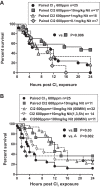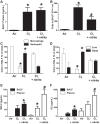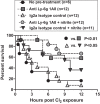Nitrite therapy improves survival postexposure to chlorine gas
- PMID: 25326579
- PMCID: PMC4254962
- DOI: 10.1152/ajplung.00079.2014
Nitrite therapy improves survival postexposure to chlorine gas
Abstract
Exposure to relatively high levels of chlorine (Cl₂) gas can occur in mass-casualty scenarios associated with accidental or intentional release. Recent studies have shown a significant postexposure injury phase to the airways, pulmonary, and systemic vasculatures mediated in part by oxidative stress, inflammation, and dysfunction in endogenous nitric oxide homeostasis pathways. However, there is a need for therapeutics that are amenable to rapid and easy administration in the field and that display efficacy toward toxicity after chlorine exposure. In this study, we tested whether nitric oxide repletion using nitrite, by intramuscular injection after Cl₂ exposure, could prevent Cl₂ gas toxicity. C57bl/6 male mice were exposed to 600 parts per million Cl₂ gas for 45 min, and 24-h survival was determined with or without postexposure intramuscular nitrite injection. A single injection of nitrite (10 mg/kg) administered either 30 or 60 min postexposure significantly improved 24-h survival (from ∼20% to 50%). Survival was associated with decreased neutrophil accumulation in the airways. Rendering mice neutropenic before Cl₂ exposure improved survival and resulted in loss of nitrite-dependent survival protection. Interestingly, female mice were more sensitive to Cl₂-induced toxicity compared with males and were also less responsive to postexposure nitrite therapy. These data provide evidence for efficacy and define therapeutic parameters for a single intramuscular injection of nitrite as a therapeutic after Cl₂ gas exposure that is amenable to administration in mass-casualty scenarios.
Keywords: acute lung injury; halogen; inflammation; nitric oxide.
Copyright © 2014 the American Physiological Society.
Figures





Similar articles
-
Administration of nitrite after chlorine gas exposure prevents lung injury: effect of administration modality.Free Radic Biol Med. 2012 Oct 1;53(7):1431-9. doi: 10.1016/j.freeradbiomed.2012.08.007. Epub 2012 Aug 11. Free Radic Biol Med. 2012. PMID: 22917977 Free PMC article.
-
Nitrite therapy prevents chlorine gas toxicity in rabbits.Toxicol Lett. 2017 Apr 5;271:20-25. doi: 10.1016/j.toxlet.2017.02.019. Epub 2017 Feb 22. Toxicol Lett. 2017. PMID: 28237808 Free PMC article.
-
Mitigation of chlorine gas lung injury in rats by postexposure administration of sodium nitrite.Am J Physiol Lung Cell Mol Physiol. 2011 Mar;300(3):L362-9. doi: 10.1152/ajplung.00278.2010. Epub 2010 Dec 10. Am J Physiol Lung Cell Mol Physiol. 2011. PMID: 21148791 Free PMC article.
-
Potential for chlorine gas-induced injury in the extrapulmonary vasculature.Proc Am Thorac Soc. 2010 Jul;7(4):290-3. doi: 10.1513/pats.201001-006SM. Proc Am Thorac Soc. 2010. PMID: 20601634 Free PMC article. Review.
-
Emergency management of chlorine gas exposure - a systematic review.Clin Toxicol (Phila). 2019 Feb;57(2):77-98. doi: 10.1080/15563650.2018.1519193. Epub 2019 Jan 23. Clin Toxicol (Phila). 2019. PMID: 30672349
Cited by
-
Safety and toxicology assessment of sodium nitrite administered by intramuscular injection.Toxicol Appl Pharmacol. 2021 Oct 15;429:115702. doi: 10.1016/j.taap.2021.115702. Epub 2021 Aug 28. Toxicol Appl Pharmacol. 2021. PMID: 34464673 Free PMC article.
-
Halogen-Induced Chemical Injury to the Mammalian Cardiopulmonary Systems.Physiology (Bethesda). 2021 Sep 1;36(5):272-291. doi: 10.1152/physiol.00004.2021. Physiology (Bethesda). 2021. PMID: 34431415 Free PMC article. Review.
-
Role of epithelial sodium channels in the regulation of lung fluid homeostasis.Am J Physiol Lung Cell Mol Physiol. 2015 Dec 1;309(11):L1229-38. doi: 10.1152/ajplung.00319.2015. Epub 2015 Oct 2. Am J Physiol Lung Cell Mol Physiol. 2015. PMID: 26432872 Free PMC article. Review.
-
Heme scavenging reduces pulmonary endoplasmic reticulum stress, fibrosis, and emphysema.JCI Insight. 2018 Nov 2;3(21):e120694. doi: 10.1172/jci.insight.120694. JCI Insight. 2018. PMID: 30385726 Free PMC article.
-
The long road to Ithaca: a physiologist's journey.Am J Physiol Cell Physiol. 2025 May 1;328(5):C1526-C1534. doi: 10.1152/ajpcell.00030.2025. Epub 2025 Feb 24. Am J Physiol Cell Physiol. 2025. PMID: 39993005 Free PMC article. Review.
References
-
- Balakrishna S, Song W, Achanta S, Doran SF, Liu B, Kaelberer MM, Yu Z, Sui A, Cheung M, Leishman E, Eidam HS, Ye G, Willette RN, Thorneloe KS, Bradshaw HB, Matalon S, Jordt SE. TRPV4 inhibition counteracts edema and inflammation and improves pulmonary function and oxygen saturation in chemically induced acute lung injury. Am J Physiol Lung Cell Mol Physiol 307: L158–L172, 2014. - PMC - PubMed
-
- Cevik Y, Onay M, Akmaz I, Sezigen S. Mass casualties from acute inhalation of chlorine gas. South Med J 102: 1209–1213, 2009. - PubMed
Publication types
MeSH terms
Substances
Grants and funding
LinkOut - more resources
Full Text Sources
Other Literature Sources
Molecular Biology Databases

